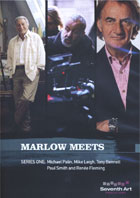
Marlow Meets: Series One 2009
Distributed by Microcinema International/Microcinema DVD, 2169 Folsom Street, Suite M101, San Francisco, CA 94110; 415-447-9750
Produced by Seventh Art Productions
Directed by Phil Grabski & Ben Harding
DVD, color, 5 episodes, 23 min. each
Jr. High - General Adult
Art Education, Art History
Date Entered: 03/28/2012
Reviewed by Kim Stanton, University of North Texas LibrariesMarlow Meets: Season One is a series of five programs about art hosted by British art historian and broadcast personality Tim Marlow. The premise of the series is interesting. In each episode a guest from the broader UK or US arts community meets Marlow at a particular museum or studio to discuss a few of his or her favorite works. The guests featured in Season One are a diverse group that includes actor Michael Palin, filmmakers Mike Leigh, singer Tony Bennett, fashion designer Paul Smith and opera singer Renee Fleming. Though all of the locations features are in London or New York City, there is still diversity in the choice of venues and art works. Benchmark museums such as the Tate Modern and the Metropolitan Museum are covered, as well as more off the beaten path locations, like the Cartoon Museum of London, the studio of Chuck Close and the personal collection of Paul Smith. The works featured are by a mix of masters and lesser known artists, through there is a strong focus on drawing and painting.
The interactions between Marlow and his guests are engaging. Most of the guests are very articulate on why a particular piece is important to them personally and how the overall style or content of their selections reflects their own artistic endeavors. On occasion Marlow challenges or pushes for more information on a guest’s statement, which often leads to a more in depth analysis of the work.
The only drawback to this series is properly identifying its audience. Fairly limited background information or context is provided about guests, locations, artworks and artists, requiring the viewer to have some existing knowledge of the subject. However, the selection and analysis of the works is not in depth enough to be appropriate for a student of art history. This series would likely be of interest to students in art education programs who are learning to engage younger students in the meaning of art. It would also be appropriate for those with a general interest in popular arts culture.
This series is recommended for general collections or those with a concentration in art, art education and humanities.